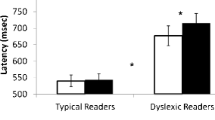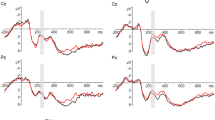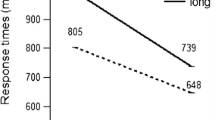Abstract
In order to become expert readers of an alphabetical language like French, students must develop and adequately use phonological knowledge. Considering that the phonological knowledge used in reading largely comes from knowledge of the oral language, what happens when the oral language is not accessible, as is the case for many deaf children? In this study, graphophonemic and syllabic processes in pseudoword reading were assessed with a similarity judgment task. Gestual deaf subjects aged 10–18 years old (N = 24) were compared to 24 age-matched hearing subjects. The results show that deaf readers are less sensitive to the graphemic and the syllabic structures of pseudo-words than hearing readers. In deaf subjects, the results are different than chance-level in the 13–15 and the 16–18-year-old groups. These results indicate that gestual deaf readers can develop phonological knowledge even in settings where sign language is promoted.
Similar content being viewed by others
Notes
The reading comprehension test was created with the Zigzag technique developed by Ciesielski & Reinwein (1989) and used in many different studies as an experimental measure or as a control measure, as in this case (for example, Bastien, 1997; see also http://www.unites.uqam.ca/zigzag). The Zigzag technique consists in a reading activity activated by a segment-by-segment autopresentation, of the text to be constructed by the reader. The readers always have the choice between two items—an expected item and a distracter—and must select the expected one in order to activate the following part of the text. The anterior context then appears in a window on the computer. For this study, subjects had to read three texts of about 100 words each. The first one was a practice text. We used the average success rate of the two experimental texts as the reading score for each subject.
References
Baccino, T., & Colé, P. (1995). La lecture experte. Paris: Presses Universitaires de France.
Bastien, M. (1997). Analyse des temps de lecture lors de moments d’incompréhension chez des sourds adultes à l’aide de la technique d’auto-présentation segmentée Zigzag. Master thesis, Université du Québec à Montréal.
Bastien, M. (2002). LÉA: Le logiciel d’évaluation des apprentissages. Montréal: Université du Québec à Montréal, Département de linguistique et de didactique des langues.
Bastien-Toniazzo, M., Magnan, A., & Bouchafa, H. (1999). Nature des représentations du langage écrit aux débuts de l’apprentissage de la lecture: Un modèle interprétatif. Journal International de Psychologie, 34, 43–58.
Burden, V., & Campbell, R. (1994). The development of word-coding skills in the born deaf: An experimental study of deaf school-leavers. British Journal of Developmental Psychology, 12, 331–349.
Castles, A., & Coltheart, M. (2004). Is there a causal link from phonological awareness to success in learning to read? Cognition, 91, 77–111.
Catach, N. (1995). L’orthographe française, (3e éd.). Paris: Nathan.
Chincotta, M., & Chincotta, D. (1996). Digit span, articulatory suppression, and the deaf: A study of the Hong Kong Chinese. American Annals of the Deaf, 141, 252–257.
Ciesielski, R., & Reinwein, J. (1989). Le test Zigzag (version 2.0 lightspeed Pascal). Montréal: Université du Québec à Montréal, Département de linguistique.
Colé, P., Magnan, A., & Grainger, J. (1999). Syllable-sized units in visual word recognition: Evidence from skilled and beginning readers of French. Applied Psycholinguistics, 20, 507–532.
Colé, P., & Sprenger-Charolles, L. (1999). Traitement syllabique au cours de la reconnaissance de mots écrits chez des enfants dyslexiques, lecteurs en retard et normo-lecteurs de 11 ans. Revue de Neuropsychologie, 9, 323–360.
Colin, S., Magnan, A., Ecalle, J., & Leybaert, J. (2007). Relation between deaf children’s phonological skills in kinergarten and word recognition performance in first grade. Journal of Child Psychology and Psychiatry, 48, 139–146.
Coltheart, V., & Leahy, J. (1992). Children’s and adults’ reading of nonwords: Effects of regularity and consistency. Journal of Experimental Psychology: Learning, Memory and Cognition, 18, 718–729.
Cunningham, A. E., & Stanovich, K. E. (1997). Early reading acquisition and its relation to reading experience and ability 10 years later. Developmental Psychology, 33, 934–945.
Demont, E., & Gombert, J. E. (2007). Relation conscience phonologique & apprentissage de la lecture: Peut-on sortir de la relation circulaire? In E. Demont & M. N. Metz-Lutz (Eds.), Acquisition du langage: Vers une approche intégrée (pp. 47–79). Marseille: Solal.
Duncan, L. G., Seymour, P. H. K., & Hill, S. (1997). How important are rhyme and analogy in beginning reading? Cognition, 63, 171–208.
Dyer, A., MacSweeney, M., Szczerbinski, M., Green, L., & Campbell, R. (2003). Predictors of reading delay in deaf adolescents: The relative contributions of rapid automatized naming speed and phonological awareness and decoding. Journal of Deaf Studies and Deaf Education, 8, 215–229.
Ehri, L. C. (1998). Graphene-phoneme knowledge is essential for learning to read words in English. In J. L. Metsala & L. C. Ehri (Eds.), Word recognition in beginning literacy (pp. 3–40). Mahwah, NJ: Lawrence Erlbaum.
Ferrand, L., Segui, J., & Grainger, J. (1996). Masked priming of word and picture naming: The role of syllabic units. Memory and Language, 35, 708–723.
Gombert, J. E. (1992). Metalinguistic development. London: Harvester Wheatsheaf.
Gombert, J. E. (1997). Les activités cognitives en œuvre dans la lecture et son acquisition. In F. Andrieux, J. M. Besse, & B. Falaize (Eds.), Illettrisme: Quels chemins vers l’écrit (pp. 129–144). Paris: Magnard.
Gombert, J. E. (2003). Implicit and explicit learning to read: Implication as for subtypes of dyslexia. Current Psychology Letters, Vol. 1, Special Issue on Language Disorders and Reading Acquisition. http://www.cpl.revues.org/document202.html
Goswami, U. (1993). Toward an interactive analogy model of reading development: Decoding vowel graphemes in beginning reading. Journal of Experimental Child Psychology, 56, 443–475.
Goswami, U. (1999). Causal connections in beginning reading: The importance of rhyme. Journal of Research in Reading, 22, 217–240.
Goswami, U. (2002). Phonology, reading development and dyslexia: A cross-linguistic perspective. Annals of Dyslexia, 52, 141–163.
Goswami, U., & Bryant, P. E. (1990). Phonological skills and learning to read. Hillsdale, NJ: Erlbaum.
Hanson, V. L., & Fowler, C. A. (1987). Phonological coding in word reading: Evidence from hearing and deaf readers. Memory and Cognition, 15, 199–207.
Harris, M., & Moreno, C. (2004). Deaf children’s use of phonological coding: Evidence from reading, spelling, and working memory. Journal of Deaf Studies and Deaf Education, 9, 253–268.
Harris, M., & Moreno, C. (2006). Speech reading and learning to read: A comparison of children with good and poor reading ability. Journal of Deaf Studies and Deaf Education, 11, 189–201.
Holt, J. A. (1994). Classroom attributes and achievement test scores for deaf and hard of hearing students. American Annals of the Deaf, 139, 430–437.
Katz, L., & Baldasare, J. (1983). Syllable coding in printed-word recognition by children and adults. Journal of Educational Psychology, 75, 245–256.
Kyle, F. E., & Harris, M. (2006). Concurrent correlates and predictors of reading and spelling in deaf and hearing school children. Journal of Deaf Studies and Deaf Education, 11, 273–288.
LaSasso, C. (1999). Critical literacy issues in deaf education in the United States. Actes du colloque international ACFOS: Surdité et accès à la langue écrite, de la recherche à la pratique, November 1998, 221–243.
Morton, J. (1989). An information-processing account of reading acquisition. In A. M. Galaburda (Ed.), From reading to neurons (pp. 43–66). Cambridge: MIT Press.
Musselman, C. (2000). How do children who can’t hear learn to read an alphabetic script? A review of the literature on reading and deafness. Journal of Deaf Studies and Deaf Education, 5, 9–31.
Olson, A. C., & Nickerson, J. F. (2001). Syllabic organization and deafness: Orthographic structure or letter frequency in reading? Quarterly Journal of Experimental Psychology, 54a, 421–438.
Prinzmetal, W., Hoffman, H., & Vest, K. (1991). Automatic processes in word perception: An analysis from illusory conjunctions. Journal of Experimental Psychology: Human Perception and Performance, 17, 902–923.
Prinzmetal, W., Treiman, R., & Rho, S. H. (1986). How to see a reading unit. Journal of Memory and Language, 25, 461–475.
Rapp, B. C. (1992). The nature of sublexical orthographic organization: The bigram trough hypothesis examined. Journal of Memory and Language, 31, 33–53.
Schaper, M. W., & Reitsma, P. (1993). The use of speech-based recoding in reading by prelingually deaf children. American Annals of the Deaf, 138, 46–54.
Seymour, P. H. K. (1997). Foundations of orthographic development. In C. A. Perfetti, L. Rieben, & M. Fayol (Eds.), Learning to spell, research, theory and practice across languages (pp. 319–337). Mahwah, NJ: Lawrence Erlbaum.
Share, D. L. (1995). Phonological recoding and self-teaching: Sine qua non of reading acquisition. Cognition, 55, 151–218.
Sprenger-Charolles, L., & Casalis, S. (1996). Lire—lecture et écriture: Acquisition et troubles du développement. Paris: Presses Universitaires de France.
Stanovich, K. E. (1990). Concepts in developmental theories of reading skill: Cognitive resources, automaticity, and modularity. Developmental Review, 10, 72–100.
Sterne, A., & Goswami, U. (2000). Phonological awareness of syllables, rhymes, and phonemes in deaf children. Journal of Child Psychology and Psychiatry and Allied Disciplines, 41, 609–625.
Taft, M., & Radeau, M. (1995). The influence of the phonological characteristics of a language on the functional units of reading: A study in French. Canadian Journal of Experimental Psychology, 49, 330–346.
Transler, C. (1999). La lecture chez les enfants sourds sévères et profonds: Analyse des traitement phonologiques et orthographiques. Ph.D dissertation, Université Libre de Bruxelles & Université de Haute Bretagne.
Transler, C., Gombert, J.-E., & Leybaert, J. (2001). Phonological decoding in severely and profoundly deaf children : Similarity judgment between written pseudo-words. Applied Psycholinguistics, 22, 61–82.
Transler, C., Leybaert, J., & Gombert, J.-E. (1999). De deaf children use phonological syllables as reading units? Journal of Deaf Studies and Deaf Education, 4, 124–143.
Transler, C., & Reitsma, P. (2005). Phonological coding in reading of deaf children: Pseudohomophone effects in lexical decision. British Journal of Developmental Psychology, 23, 525–542.
Treiman, R., & Hirsh-Pasek, K. (1983). Silent reading: Insights from second-generation deaf readers. Cognitive Psychology, 15, 39–65.
Treiman, R., & Zukowski, A. (1996). Children’s sensitivity to syllables, onsets, rimes, and phonemes. Journal of Experimental Child Psychology, 30, 73–87.
Waters, G. S., & Doehring, D. B. (1990). Reading acquisition in congenitally deaf children who communicate orally: Insights from an analysis of component reading, language, memory skills. In T. H. Carr & B. A. Levy (Eds.), Reading and its development: Component skills approaches (pp. 323–373). San Diego, CA: Academic.
Acknowledgements
We would like to thank the subjects, their parents and the schools for generously participating in this study. We would also like to thank Audrey Dupont, Lynda Lelièvre and Marijo Tradif for their help in collecting and processing the data. We also thank Elisabeth Demont and Jean-Emile Gombert for their valuable comments on previous versions of this article. Finally, a special word of thanks goes out to Miguel Chagnon who helped with the statistical analyses.
Author information
Authors and Affiliations
Corresponding author
Appendixes
Appendixes
Rights and permissions
About this article
Cite this article
Daigle, D., Armand, F. Phonological sensitivity in severely and profoundly deaf readers of French. Read Writ 21, 699–717 (2008). https://doi.org/10.1007/s11145-007-9087-5
Received:
Accepted:
Published:
Issue Date:
DOI: https://doi.org/10.1007/s11145-007-9087-5




